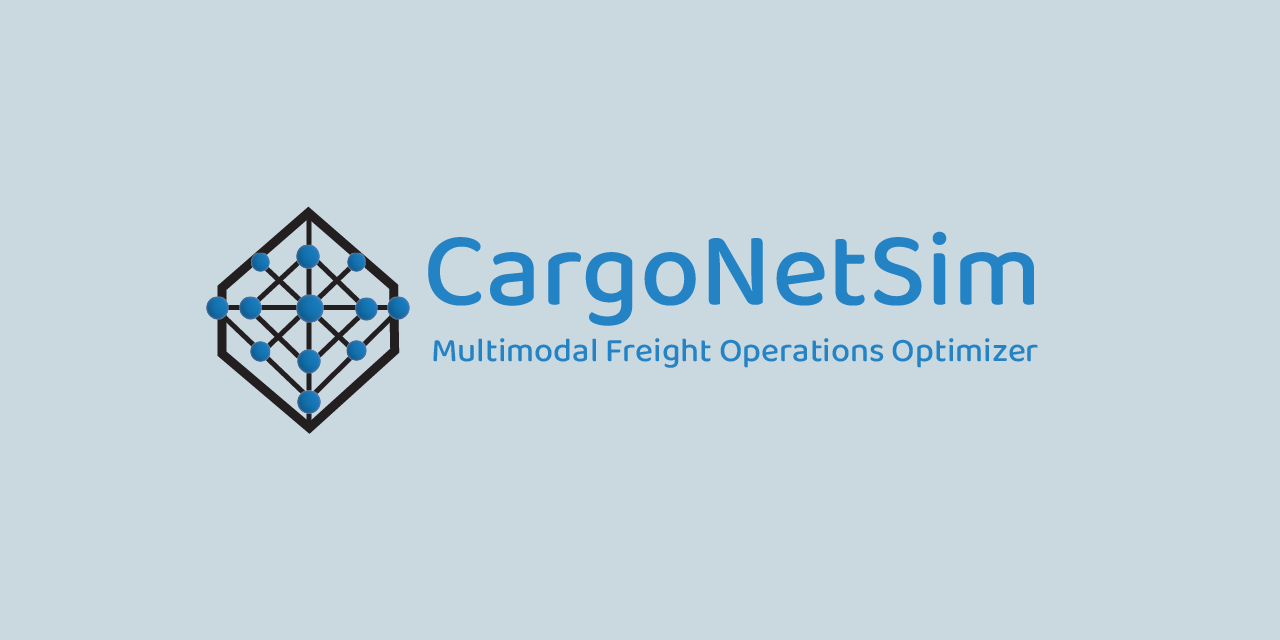Cargo Network Simulator (CargoNetSim)
Open Source Multimodal Freight Operations Optimization Tool with GUI for designing, simulating, and analyzing complex logistics networks 
Open Source Multimodal Freight Operations Optimization Tool with GUI for designing, simulating, and analyzing complex logistics networks 
Open Source Maritime Network Simulator for Real-Time Energy Consumption and Emission Analysis 
Open Source Network Train Simulator for Large-Scale Railway Network Analysis and Energy Optimization 
Published in IEEE Engineering Management Review, 2019
This paper surveys the impact of 4D BIM on construction project scheduling and coordination, highlighting its advantages over traditional 2D planning methods and the preference for the Critical Path Method (CPM).
Recommended citation: Aredah, A. S., Baraka, M. A., & ElKhafif, M. (2019). "Project Scheduling Techniques Within a Building Information Modeling (BIM) Environment: A Survey Study." IEEE Engineering Management Review. 47(2), 133-143. DOI: 10.1109/EMR.2019.2916365.
Download Paper
Published in International Journal of Construction Project Management, 2021
This paper evaluates 4D BIM, comparing CPM and LBMS scheduling techniques through case studies, highlighting their effectiveness in reducing planning conflicts and optimizing project schedules.
Recommended citation: Aredah, A. S., Baraka, M., & Elkhafif, M. (2021). "The Fourth Dimension of Building Information Modelling (4D BIM): An Investigation and Simulation Approach." International Journal of Construction Project Management. 13(2), 195-213.
Download Paper
Published in Water Supply, 2022
This paper presents an Extreme Learning Machine (ELM) model to predict stream health using the Qualitative Habitat Evaluation Index (QHEI) and watershed metrics, demonstrating high predictive accuracy and insights into stream health factors.
Recommended citation: Ahmed S. Aredah, Omer Faruk Ertugrul, Ahmed A. Sattar, Hossein Bonakdari, & Bahram Gharabaghi (2022). "Extreme Learning Machine Model for Assessment of Stream Health Using the Habitat Evaluation Index." Water Supply. 22(5), ws2022166. DOI: 10.2166/ws.2022.166.
Download Paper
Published in Energies, 2023
This paper introduces a simple and accurate diesel train energy consumption model for real-time applications, validated against real-world data and suitable for transportation planning and policy evaluation.
Recommended citation: Ahn, K., Aredah, A., Rakha, H. A., Wei, T., & Frey, H. C. (2023). "Simple Diesel Train Fuel Consumption Model for Real-Time Train Applications." Energies. 16(8), 3555. DOI: 10.3390/en16083555.
Download Paper
Published in Applied Energy, 2024
This study evaluates the energy efficiency and environmental impact of six powertrain technologies for freight trains, highlighting the potential of electric powertrains and advanced technologies in achieving sustainable rail transport.
Recommended citation: Aredah, A., Du, J., Hegazi, M., List, G., & Rakha, H. A. (2024). "Comparative Analysis of Alternative Powertrain Technologies in Freight Trains: A Numerical Examination Towards Sustainable Rail Transport." Applied Energy. 356, 122411.
Download Paper
Published in Applied Energy, 2024
This research applies multi-objective dynamic programming and a heuristic A* algorithm to optimize energy efficiency in freight train operations across six powertrain technologies, evaluating their impact on energy consumption and travel time in the U.S. freight network.
Recommended citation: Aredah, A., Fadhloun, K., & Rakha, H. A. (2024). "Energy Optimization in Freight Train Operations: Algorithmic Development and Testing." Applied Energy. 364, 123111.
Download Paper
Published in Railway Engineering Science, 2024
This paper introduces NeTrainSim, a simulator designed to model the longitudinal motion and energy consumption of heavy freight trains across a network of intersecting tracks. It enables comprehensive analysis of energy consumption and carbon footprint for entire train systems.
Recommended citation: Aredah, A. S., Fadhloun, K., & Rakha, H. A. (2024). "NeTrainSim: A Network-Level Simulator for Modeling Freight Train Longitudinal Motion and Energy Consumption." Railway Engineering Science. 1-19.
Download Paper
Published in Journal of Marine Science and Engineering, 2025
This paper introduces ShipNetSim, an open-source multi-ship simulator that combines hydrodynamic modeling, dynamic ship-following techniques, real-time environmental data, and cybersecurity threat simulation to quantify and evaluate marine fuel consumption and CO2 emissions.
Recommended citation: Aredah, A., & Rakha, H. A. (2025). "ShipNetSim: An Open-Source Simulator for Real-Time Energy Consumption and Emission Analysis in Large-Scale Maritime Networks." Journal of Marine Science and Engineering, 13(3), 518.
Download Paper
Published:
Published:
Published:
Undergraduate course, German University in Cairo (GUC), Civil Engineering Program, 2016
The course is an advanced level course in mapping and surveying sciences. Geodetic surveying measurements and computation outcomes are refined and better suited to meet the requirements of high quality surveys and the needs of special purpose civil engineering work. The historical developments and advances in geodetic surveying are reviewed, up to the time of satellite positioning. Concepts of reducing geodetic surveying measurements to a spherical or ellipsoidal datum are studied. Computations of geodetic quantities such as; length of arcs along meridians and parallels, spherical excess, solutions of spherical triangles, geodetic azimuths and convergence of meridians, computations are practiced and related to civil engineering examples. Geodetic considerations are highlighted for the use of regional and/or worldwide reference ellipsoids in geodetic coordinate determination, derived geodetic quantities and datum transformations. An introduction to least squares principles and its uses within geodetic computations and geodetic control networks are delineated. Astronomic coordinates and astronomic coordinate systems are identified in relation to geodetic datum definitions and geodetic control networks realizations. The Global Positioning System (GPS) positioning concept is revisited and expanded upon, in view of GPS extended role in geodetic control networks; and specification and standards for geodetic and GPS surveys. An overview of the Global Navigation Satellite Systems (GNSS) “The System of Systems”; its sub-systems, current status, and engineering applications. GPS, GLONASS, Galileo and Compass satellite sub-systems are examined. Advances in real-time differential GPS (DGPS) observations corrections techniques and coordinate determination are investigated, along with case studies in surveying projects and engineering applications. Basic concepts and recent advances in GPS positioning services, e.g. continuously operating reference stations (CORS) and European Geostationary Navigation Overlay Service (EGNOS) are presented.
Undergraduate course, German University in Cairo (GUC), Civil Engineering Program, 2016
The main purpose of this introductory course is to provide “Civil Engineering” students with ample information as regards conventional materials used in the civil/construction domain. Materials such as concrete, steel, masonry, asphalt, wood and composites differ in their properties (e.g. molecular structure, mechanical behaviour and physical properties); all addressed within the course content. For each of the former materials this course provides the necessary understanding of their nature, constituents, manufacturing process and applications. Mechanical and physical-property tests are conducted (in laboratory and in-situ); data is obtained and analysed; information content is drawn as regards material properties and classification. This introductory course yields the fundamentals for other design courses such as “Reinforced Concrete Design” and “Steel Structures Design”. It is also a mandatory prerequisite for other materials’ related courses that deal with “Concrete Technology”, “Repair and Strengthening of Concrete Structures” and “Innovative Construction Materials”.
Undergraduate course, German University in Cairo (GUC), Civil Engineering Program, 2017
This course introduces the basics of surveying theory. Students learn recording field data, data representation, scales and measurement units, field sketches, electronic methods of linear measurements, Azimuth methods of observing angles and their associated errors, digital mapping production and contouring. The course involves field work, survey planning and associated survey calculations, as well as an introduction to 3D scanning of buildings.
Undergraduate course, German University in Cairo (GUC), Civil Engineering Program, 2017
Drawing is the language of engineers and technicians working in the different phases of a project. The course Civil Engineering Drawing differs from Engineering Drawing and is tailored for areas and tasks specific in civil engineering projects. Especially in this discipline, drawings have a legally binding character and must be clear, non-unanimous and follow certain conventions and standards. This counts the more as we are normally dealing with projects of a one-time-, unique character. First, the meaning and importance of drawings shall be demonstrated to the students; followed by explanations on drawing conventions and standards as well as systems to identify and administer the large number of drawings in a civil engineering project. This will be followed by principles of drawing techniques to learn how to prepare a drawing by hand. In the last third of the course, the use of drawing software (AutoCAD) will be introduced. The course will cover a theoretical part at the very beginning, followed by lectures demonstrating the use of drawings in the various disciplines of civil engineering, i.e. reinforced concrete structures, steel structures, hydro structures and traffic structures and surveying. By the end of the course there will be an introduction to drawing software (AutoCAD) through tutorials.
Undergraduate course, German University in Cairo (GUC), Civil Engineering Program, 2017
Structural analysis is considered the most essential core course for civil and structural engineering. It provides the fundamental understanding of the distribution and transmission of loads in any structural form. Statically determinate structures, such as beams, frames and trusses are thoroughly studied. The student should be able to evaluate all the internal forces and straining actions in these structural forms under various kinds of loads and different loading cases.
Undergraduate course, German University in Cairo (GUC), Civil Engineering Program, 2017
Construction Management II is a core course for all civil engineering students. The course contents are considered relevant for engineers working in the project practice. After Construction Management I which concentrated on construction methods, this successor course focuses on the managerial aspects of project implementation. This starts with the organization of a construction site (site establishment, project administration, personnel organization), followed by planning and scheduling of construction activities, quality management, safety management. Cost estimation, budgeting, cash-flow and cost control are introduced as essential aspects of managing the construction process and a basic introduction to construction contracts is given. Students are given in the lectures relevant websites which are recommended for visit to further enhance the understanding of the course subject.
Undergraduate course, German University in Cairo (GUC), Civil Engineering Program, 2017
Steel structures represent a major portion of the construction industry. This course provides the students with the basic knowledge about the choice of the appropriate structural system, design of structural elements under various straining actions, design of beams, design of beam-columns and design of all the structural connections. Introduction of the ASD and LRFD design philosophies is also covered by the course.
Undergraduate course, German University in Cairo (GUC), Civil Engineering Program, 2018
The course is offered to students of the General Civil Engineering major and introduces building construction with a special emphasis on high-rise buildings and its components. This includes special aspects for the construction of the foundation and structure. Deep foundation methods to transfer the concentrated loads of high-rise buildings are presented as well as the methods of building vertical concrete structures of great height which specifically means the formwork and scaffolding systems, lifting equipment and concrete pumping and pouring equipment. Typical cycle times are explained. External and internal finishing trades are presented with special aspects of modern facades and mechanical & electrical works and their implementation until testing and commissioning. Students are introduced to the life-cycle approach and maintenance aspects for buildings. Students are given in the lectures relevant websites which are recommended for visit to further enhance the understanding of the course subject.
Undergraduate course, German University in Cairo (GUC), Civil Engineering Program, 2018
Undergraduate course, German University in Cairo (GUC), Civil Engineering Program, 2018
The course addresses as a core course all civil engineering students of the 6th semester and presents an introduction to the wide field of construction management within the process of realising a project, its requirements, tasks and relationship to other disciplines in the environs of a project. It also gives an introduction to the development of a project per se, including its life cycle and to specific organizational aspects. An introduction to equipment technology will be given as a base knowledge to understand how construction machinery if today is working. This is followed by the different construction methods for earth and road works, foundation and structure. Finishing trades are presented with their components and implementation issues for finishing trades. Main objective of the course is to provide the students with solid basic knowledge on the subject and to raise sensibility for the holistic approach of the project implementation process. This specifically includes the understanding that working within a wide and dynamic field “learning how to learn” is essential. Students are given in the lectures relevant websites which are recommended for visit to further enhance the understanding of the course subject.
Undergraduate course, German University in Cairo (GUC), Civil Engineering Program, 2018
The aim of the course is to develop a deeper understanding of structural steelwork design based on limit state principles. The material covered in the course enable students to familiarize with the Load and Resistance Factor Design (LRFD). The course begins with the design of cold-formed sections and steel-concrete composite beams. This is followed by the design of plate girders. A general description is given of the plate girder behaviour in terms of elastic buckling of web in shear and bending, and web in tension field action. Students are introduced to detailed design of stiffeners, splices and moment connections. Students are also introduced to fatigue behaviour of steel structures: factors affecting fatigue behaviour, recommended details, stress range, load cycles. Finally, a summary to the design of tubular structures and their connections is demonstrated.
Undergraduate course, German University in Cairo (GUC), Civil Engineering Program, 2018
Highway design: To provide delegates with an understanding of the interrelation between the capacity and geometry of major highways and appreciate how the highway structure may be fitted into the existing terrain. Although the focus is on major highways, the principles may be applied to local roads and developments. Railway design: Study of the principles of railroad location, construction, rehabilitation, maintenance, and operations with emphasis on track structure design and analysis, bridges and bridge loading, drainage considerations, track geometry effects, and operating systems analysis.
Undergraduate course, German University in Cairo (GUC), Civil Engineering Program, 2018
This course provides an overview of the design and operation of modern airport transportation system, including airside, terminal and groundside elements. Current trends in the transportation industry and their impact on air travel demand and airport operations are introduced. Aviation demand management and forecasting is studied, as are aircraft and passenger characteristics. A central focus is on airfield and terminal building design. Brief consideration is given to critical environmental issues facing airports, particularly noise and water pollution, as well as to issues of airport economics and finance.